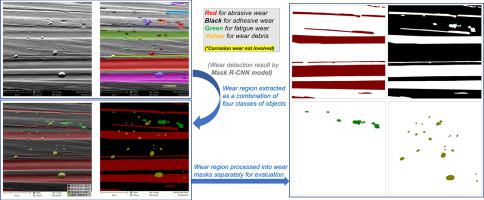International Journal of Refractory Metals & Hard Materials ( IF 3.6 ) Pub Date : 2021-03-24 , DOI: 10.1016/j.ijrmhm.2021.105530 Wucheng Sun , Hui Gao , Songcheng Tan , Zhiming Wang , Longchen Duan

|
The working efficiency and lifetime of impregnated diamond tools are closely related to their wear conditions, among which different wear modes of the metal matrix play an essential role. Since traditional qualitative description cannot meet the requirement of mathematical relationship establishment, a deep learning method, Mask R-CNN, was applied for the quantitative determination of the matrix wear based on scanning electron microscope (SEM) images. A series of WC-Cu based metal matrix composite (MMC) samples had been prepared by hot-pressed sintering, followed by a pin-on-disc wear test to obtain the wear surface images, and the datasets were established based on a normal wear classification principle where classification is of four basic types: abrasive wear, adhesive wear, fatigue wear and corrosion wear (corrosion wear is not involved in this study). After training, validation, and test based on the SEM wear image datasets, the wear segmentation results from the trained model indicated that Mask R-CNN could automatically identify the wear of metal matrices efficiently and accurately, which was in good agreement with the results obtained by manual labelling. By modifying the algorithm codes, the masks of abrasive, adhesive, and fatigue wear were extracted and counted for model effectiveness evaluation. Moreover, the wear condition values (i.e., wear region areas) obtained from extracted masks would be easily applied for correlation analysis between cutting tool qualities and drilling efficiencies in future research as well. In comparison with statistic results by artificial cognition, the three types of wear showed an average wear region mask IoU over 70%, and an average wear region area loss of less than 3%. In the process of wear detection on similar wear images in published work, the Mask R-CNN model also presented good performances. All related codes and SEM image datasets are available at https://github.com/sunwucheng/IDB_matrix_wear.
中文翻译:

基于SEM图像和深度学习的WC-Cu基浸渍金刚石钻头矩阵的磨损检测。
浸渍金刚石工具的工作效率和寿命与其磨损状况密切相关,其中金属基体的不同磨损方式起着至关重要的作用。由于传统的定性描述无法满足建立数学关系的要求,因此基于扫描电子显微镜(SEM)图像,采用了深度学习方法Mask R-CNN来定量确定基体磨损。通过热压烧结制备了一系列WC-Cu基金属基复合材料(MMC)样品,然后进行了针-盘磨损测试以获得磨损表面图像,并基于正常磨损建立了数据集分类原则,其中分类有四种基本类型:磨料磨损,粘着磨损,疲劳磨损和腐蚀磨损(本研究不涉及腐蚀磨损)。经过基于SEM磨损图像数据集的训练,验证和测试后,训练模型的磨损分割结果表明Mask R-CNN可以自动,高效,准确地识别金属基体的磨损,与获得的结果非常吻合通过手动标记。通过修改算法代码,可以提取出磨料,胶粘剂和疲劳磨损的防护层并进行计数,以进行模型有效性评估。此外,从提取的面罩获得的磨损条件值(即磨损区域面积)也将很容易应用于未来研究中刀具质量与钻孔效率之间的相关性分析。与通过人工认知得出的统计结果相比,这三种磨损类型显示平均磨损区域面罩IoU超过70%,平均磨损区域面积损失小于3%。在已发表的工作中对相似磨损图像进行磨损检测的过程中,Mask R-CNN模型也表现出良好的性能。所有相关代码和SEM图像数据集均可在https://github.com/sunwucheng/IDB_matrix_wear上获得。


























 京公网安备 11010802027423号
京公网安备 11010802027423号